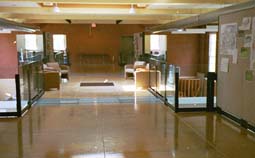Anyone who has ever been involved in a campus improvement project knows that virtually everyone has a distinct (and often strongly voiced) opinion when it comes time to pick the paint colors. While some people are virtuosi when it comes to creating aesthetic effects, most of us would be pleased to be considered knowledgeable — connoisseurs rather than dilettantes.
Aesthetics fit into a broader context. Humankind finds comfort in ordered, balanced, serene surroundings. People take pride in making beautiful places. These are natural and noble impulses, which only surround a sense of well-being generated by other conditions.
Abraham Maslow suggests that only those who have had their basic needs addressed are prepared to grapple with higher-order issues. A starving man has little interest in the texture and piquancy of a sauce. For the hungry, the aesthetic experience can be deferred. Issues of survival and comfort supercede enhancements.
Occasionally on university campuses, aesthetic issues are the prominent focus for capital improvements, while other more fundamental needs are not adequately addressed. It is in such instances that aesthetics become an expensive thing.
Discussion in the academic and professional press in recent months has focused on buildings on campuses that represent the latest quicksilver thoughts in aesthetic trends. (cf. Chronicle of Higher Education, Architectural Record). Several articles have suggested that a client's premature focus on appearances may short-change issues of purpose and practicality. I can think of one such instance where the canopy over the main entrance to a new building (presumably erected to shelter inhabitants from rain and snow) is replete with Swiss-cheese holes in keeping with the visual "design concept". Perhaps there is something uplifting about being drenched while fumbling to find one's key that the rest of us don't yet understand.
In such cases, institutional leaders are called to task for commissioning works of art that are metaphors for what might go on inside them, rather than functional and supporting environments for real people and definable tasks. New (or renewed) facilities need to be tractable in an evolving world — designed for effective adaptation to changing uses over time.
Toward making buildings effective, one client of ours begins each new capital project by charging a representative group of end users and facility managers to develop consensus and draft a concise mission statement. The committee clarifies the purpose of the facility they will inhabit and maintain. Their vision enables designers and decision-makers to better understand and deliver what is needed. Then, a facility program is developed through a collegial process, prior to design team selection. Only after the rationale has been laid out do aesthetics even enter the conversation.
The educable (connoisseurs) look to historic precedent. The Vitruvian dictum is still useful for creating new buildings and campuses –— firmness, commodity, delight. First things first: the construction stands, accommodates its users, and thereafter pleases the perceptive.
Philosophic considerations aside, experience is jaded by fiscal reality. In the end, somebody's got to pay for these things; and they might as well work for the purposes intended.
At least that's the view from a practitioner's perspective.

Charles Craig
|




